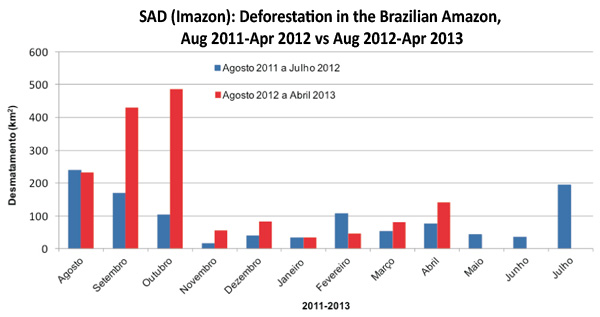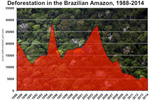Satellite analysis by a Brazil-based NGO indicates that deforestation in the Brazilian Amazon continues to pace well ahead of last year, when the government passed a weakened version of its law governing use of forest lands.
Imazon’s near-real-time deforestation tracking system — known as SAD — detected 1,570 square kilometers of accumulated forest loss between August 2012 and April 2013, an 88 percent increase over the 836 sq km cleared during the year earlier period. However accumulated forest degradation was down by nearly a quarter, according to the system.
The Brazilian government’s own tracking system suggests a more moderate rise in deforestation between the two periods. INPE, Brazil’s National Space Research Agency, earlier this month released its numbers, which estimated forest loss between August 2012 and April 2013 at 1864 sq km, 14 percent higher than the 1631 sq km from a year earlier.


In either case the near-real-time systems aren’t as accurate as the systems used for tracking annual deforestation, which is measured at the peak of the dry season each year when cloud cover is at a minimum. The shorter-term tools, which have relatively coarse resolution, are used mostly for alerting authorities on the location of forest clearing, rather than measuring changes in forest cover.
While deforestation appears to be tracking higher this year, it’s still well below historical levels. Nevertheless were deforestation to double over last year’s 4,656 sq km, Brazil would miss its 2013 target of limiting clearing to 8,000 sq km. That target is set to ratchet down to 5,586 sq km in 2014.
The drivers behind the rise in deforestation are still unclear, but one factor could be last year’s revision of the country’s Forest Code, which limits how much forest can be cleared on private lands in the Amazon. Environmentalists fighting changes to the code, said the revision could lead to an increase on forest conversion for cattle pasture and farms. Brazil’s currency, the real, has also weakened since last April, making its agricultural exports more competitive and more profitable for farmers.
More than 60 percent of the Amazon rainforest — Earth’s largest tropical forest — is located in Brazil.
Related articles
Continued deforestation in the Amazon may kill Brazil’s agricultural growth
(05/09/2013) Continuing deforestation in the Amazon rainforest could undermine agricultural productivity in the region by reducing rainfall and boosting temperatures, warns a new study published in the journal Environmental Research Letters.
Brazil’s satellite monitoring reduced Amazon deforestation by 60,000 sq km in 5 years
(05/08/2013) Brazil’s advanced satellite monitoring system, coupled with increased law enforcement, was responsible for nearly 60 percent of the 101,000 square kilometer-drop in deforestation observed between 2007 and 2011, argues a new study published an international think tank.
Brazil’s success in reducing deforestation will be hard to replicate
(04/23/2013) The sharp reduction in deforestation in the Brazilian state of Mato Grosso since the mid-2000s will be difficult to replicate in other tropical countries where commodity production is a major driver in forest loss, argues a new study published in a special issue of the journal Philosophical Transactions of the Royal Society B.
Parks, indigenous territories are effectively reducing Amazon deforestation

(03/11/2013) Strict conservation areas and indigenous reserves are more effective at reducing deforestation in the Brazilian Amazon relative to ‘sustainble-use’ areas set up for non-indigenous resource extraction, reports a new study published in the journal Proceedings of the National Academy of Sciences. The research, which involved an international team, compared rates of forest loss between different categories of managed lands using satellite imagery and statistical analysis.
Loans tied to environmental compliance reduced Amazon deforestation by 15%
(01/30/2013) A rural credit law that ties loans to environmental compliance made a significant contribution to reducing deforestation in the Brazilian Amazon between 2008 and 2011, argues a study published by the Climate Policy Initiative (CPI).
Brazil’s deforestation at record low from 2011-2012

(11/27/2012) Deforestation in the Brazilian Amazon fell to the lowest rate since annual record-keeping began in 1988 according to provisional data released Tuesday by Brazil’s National Space Research Agency (INPE). 1,798 square miles (4,656 square kilometers) of Amazon forest was chopped down during the 12 months ending July 31, 2012, 27 percent less than the year earlier period.
Most controversial aspects of Brazil’s new Forest Code vetoed as legislation signed into law
(10/19/2012) Brazilian President Dilma Rousseff signed into law a revised version of the country’s Forest Code, vetoing some of the most controversial changes proposed by agricultural interests in Brazil’s Congress.